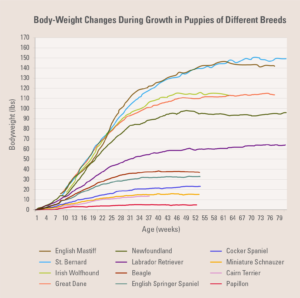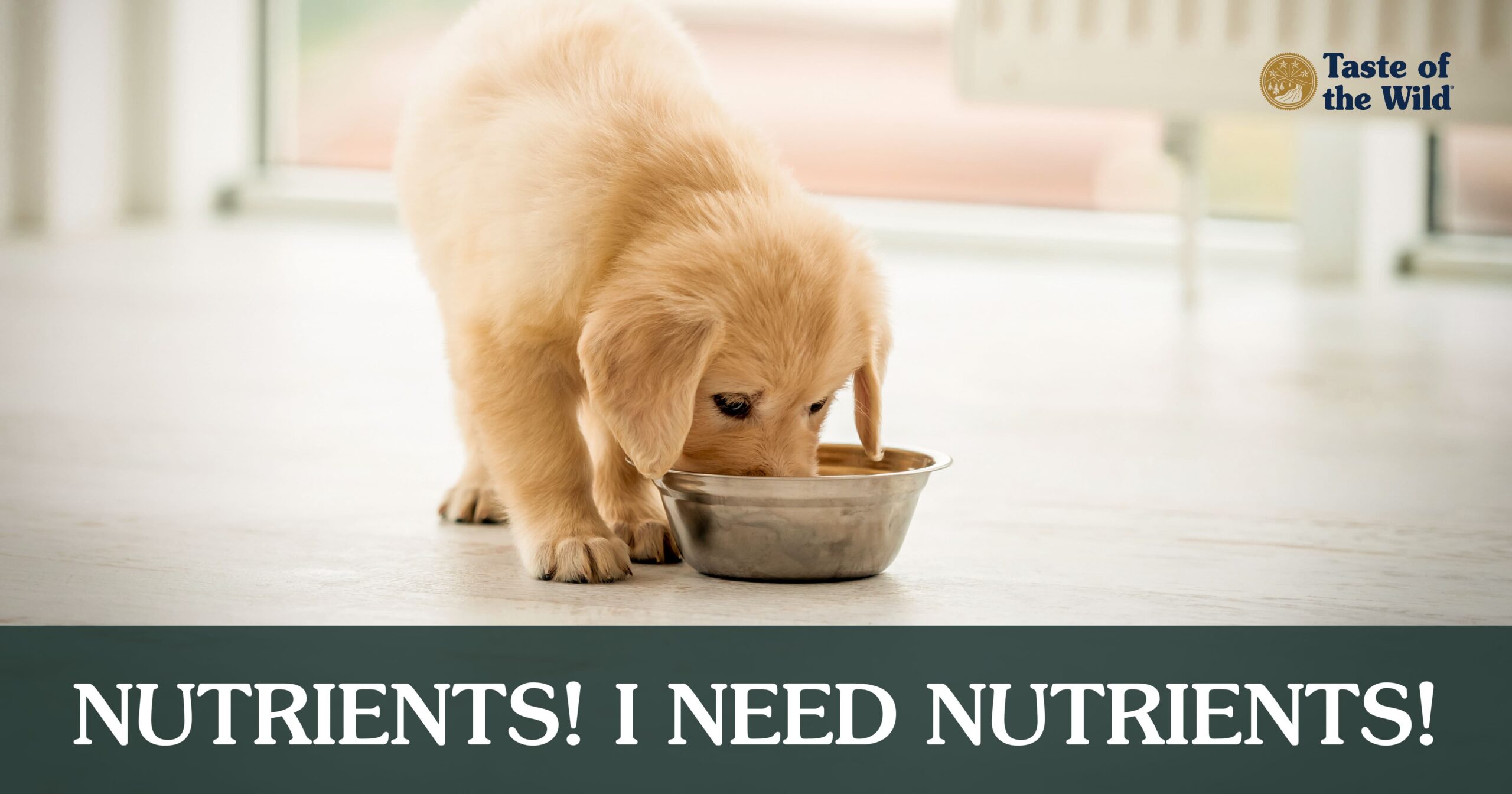Fueling Your Puppy’s Growth with the Right Food
Thursday, February 16, 2023 | Puppies

If there’s one thing puppies like to do (other than chew), it’s eat. Food is what fuels their rapid growth and development, which is why it’s important that the food they eat helps them grow and develop properly.
Once you bring your puppy home (and name them), it’s important to understand that puppies have different nutritional needs than adult dogs, and puppies of different breeds and sizes have different nutritional requirements. For example, a dachshund will reach their mature size and weight a lot quicker than a large breed pup like a Great Dane, so they will have different nutritional requirements. Keep reading to learn about how puppy growth rates affect nutrient requirements and the food options that are available for your puppy.
Puppies Reach Adult Size at Different Ages
Dog breeds are typically categorized as small (including toy and teacup), medium and large (including giant). As adults, small breeds are usually less than 20 pounds, medium breeds range between 25 and 55 pounds and large breeds are more than 50 pounds — although the Association of American Feed Control Officials (AAFCO) uses 70 pounds or more for their large breed definition.
All puppies grow rapidly during the first 3 to 6 months of life. Small breed dogs will end their rapid growth period earlier (around 3 months of age) compared to giant breed puppies, who will continue growing rapidly for a couple more months. The graph below shows the growth rates of puppies from a range of breeds of different sizes.

When your puppy celebrates their first birthday, they are officially considered an adult dog. But that doesn’t necessarily mean they have reached their adult size, as not all puppies reach adult size by 12 months. Toy, small and some medium-sized dogs reach adult size at around 8 to 10 months of age, while other medium dogs take until 9 to 12 months. Large and giant breeds don’t typically reach mature size until around 11 to 15 months, with some giant breeds reaching adult size at around 18 to 24 months old.
Every dog is different, so some puppies may grow faster or slower than their breed average. Even after they reach their mature size, dogs still continue developing for several more months — for example, after their bones have fully developed they will continue to add fat and muscle. To support all of this growth and development, they need to receive a complete and balanced diet that contains the right nutrients in the correct amounts.
Puppies Are Full of Energy — and So Is Their Food
Compared to adult dogs, puppies have a greater requirement for energy (calories), amino acids, and minerals such as calcium and phosphorus (for strong bones) and copper and zinc (for healthy immune systems). Puppies can also benefit from increased levels of the omega-3 fatty acid DHA (docosahexaenoic acid), which is important for brain and vision development.
Energy is the most important factor affecting puppy growth rates. Early in life, about half of a puppy’s caloric intake goes toward growth, but as they get older and their growth rate slows, so do their energy needs. Puppies obtain most of their energy from the fats and carbohydrates in their food, which is why you’ll find higher fat levels in puppy foods.
Calcium is important for puppy growth and development, but too much calcium in the diet can also be a bad thing. During the rapid growth period, puppies can have trouble regulating calcium absorption in their body as that mechanism isn’t fully mature. Large breed puppies tend to be more sensitive to excessive dietary calcium than small and medium breeds, and it can negatively affect their skeletal formation and growth. Once the calcium absorption process in their small intestine is fully mature, they can protect themselves better from absorbing too much calcium from their diet.
Choosing the Right Food for Your Pup
Puppies can eat food formulated for puppies or they can eat an all-life-stages food. Some formulas labeled for puppies, like High Prairie Puppy Recipe with Roasted Bison & Roasted Venison and Pacific Stream Puppy Recipe with Smoke-Flavored Salmon provide the nutrients puppies need in an easy-to-enjoy small kibble size. Both of these formulas have guaranteed levels of DHA and perfectly balanced nutrition, which means they can be fed to pregnant or nursing mothers or other adult dogs, too.
If you have a large breed puppy, make sure you check for a specific AAFCO statement on the label. AAFCO uses life stages, not weight, to distinguish between their nutrient profile categories — with one exception. If a growth or all-life-stages dog food has been formulated to meet the nutritional requirements specified in the AAFCO dog food nutrient profiles, the statement must specifically state if the food meets the growth of large size dogs. Two example AAFCO statements are below.
- “Taste of the Wild Ancient Mountain Canine Recipe with Roasted Lamb is formulated to meet the nutritional levels established by the AAFCO Dog Food Nutrient Profiles for All Life Stages, including growth of large size dogs (70 lbs. or more as an adult).”
- “Taste of the Wild Appalachian Valley Small Breed Canine Recipe is formulated to meet the nutritional levels established by the AAFCO Dog Food Nutrient Profiles for maintenance.”
In this example, the second recipe is formulated for small breeds and doesn’t meet the AAFCO requirements for the growth of large size dogs.
How Much Should Your Puppy Eat?
Some puppies will guzzle down as much food as you give them. But while puppy rolls are cute, it’s important for your puppy’s long-term health that they eat an amount appropriate for their age and size. Veterinarians recommend feeding a measured amount of food at each meal to avoid obesity issues later in life. The feeding guide on the dog food package can be used as a starting point on how much to feed, but this may need to be adjusted to keep your puppy within their ideal body condition range.
How often you feed your puppy depends on their age. Nutritionists recommend feeding puppies at least two meals and possibly three or four meals daily until your puppy reaches 4 to 6 months of age (the rapid growth period). After 6 months, two meals a day is the recommended amount, but some large and giant breeds may benefit from three feedings.
Nutrition is an important part of ensuring your puppy grows up to become a healthy adult dog. If you have questions about which food or how much food to feed your puppy, ask your veterinarian or a veterinary nutritionist for advice.
RELATED POST: A Taste of the Wild Guide to Choosing the Right Pet Food
The information in this blog has been developed with our veterinarian and is designed to help educate pet parents. If you have questions or concerns about your pet’s health or nutrition, please talk with your veterinarian.





